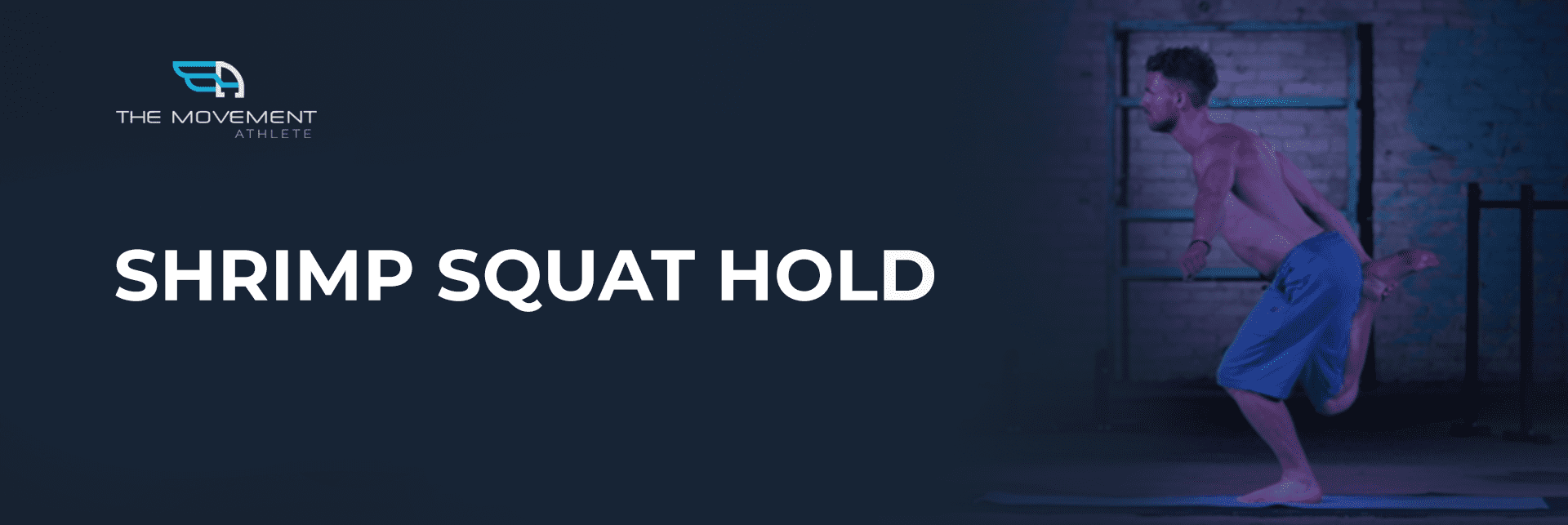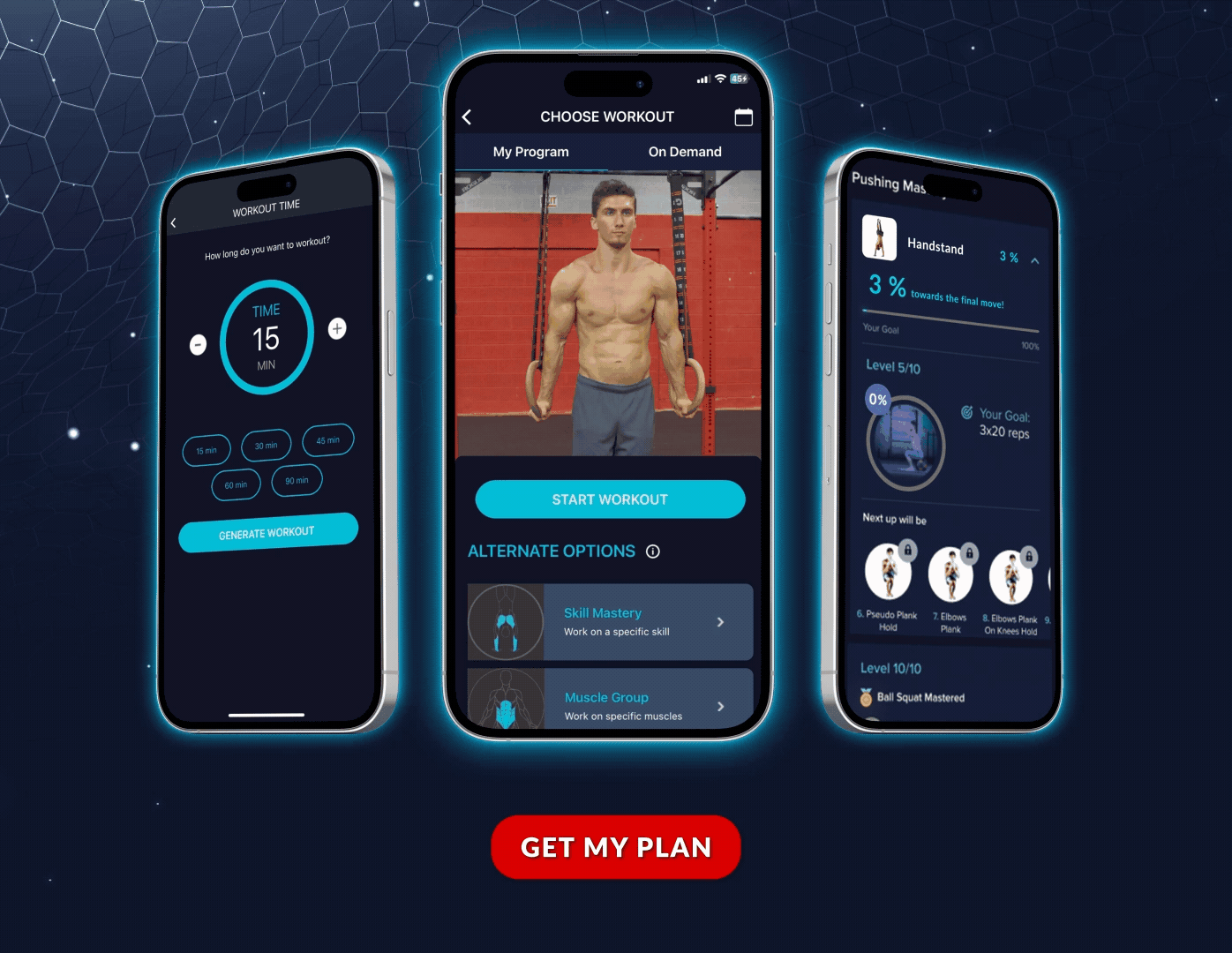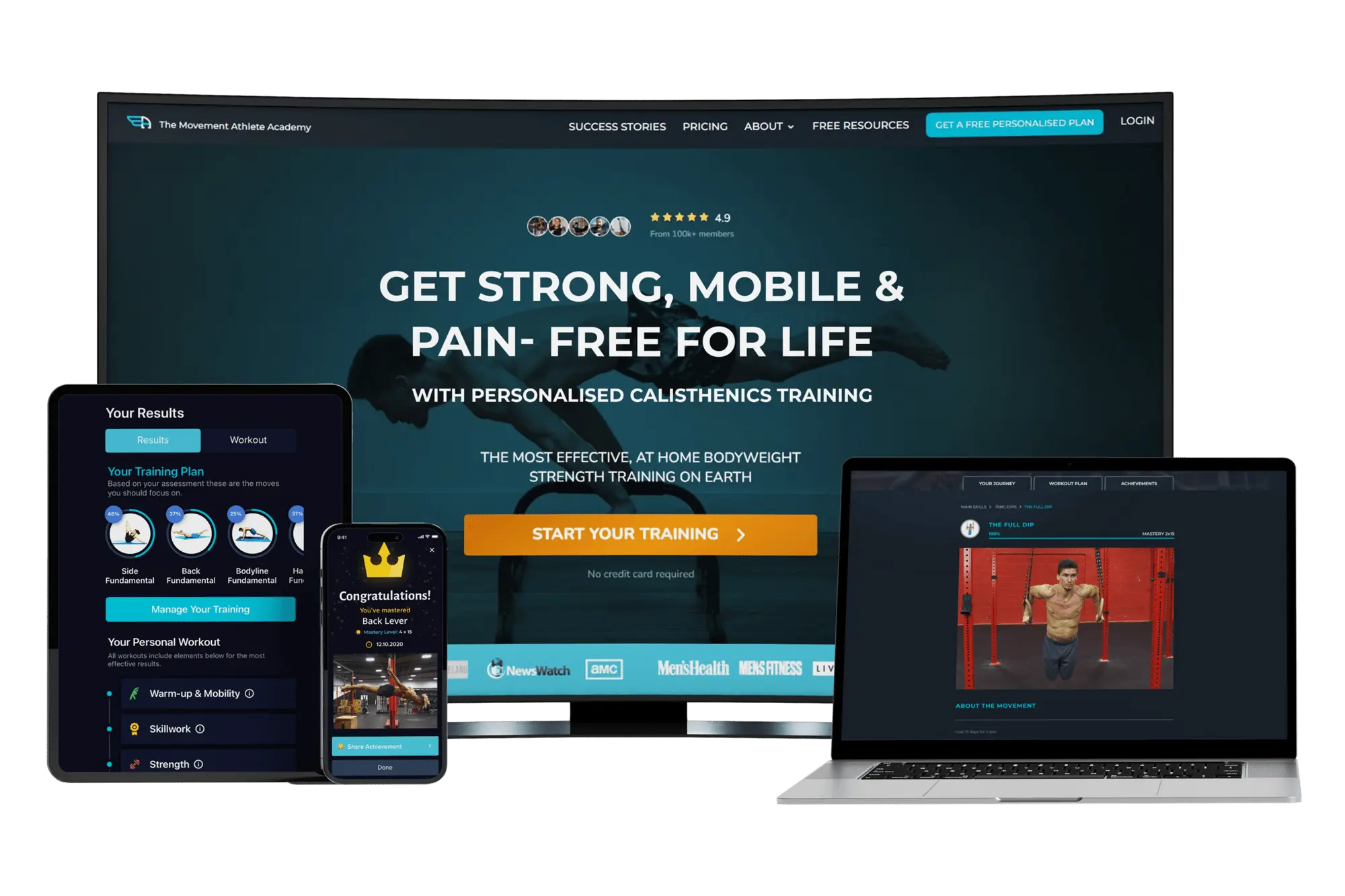

📖 Read time: 6 minutes
🏋️♂️ Join the tribe of 232,246 Movement & Calisthenics Athletes
Free assessments, ebooks, and email series to help you get started with calisthenics
✅ Free personalized assessment
✅ Human support & guidance
✅ Access to free resources
Have you ever watched someone perform a perfect pistol squat and thought, “I’ll never be able to do that”? What if I told you there’s a lesser-known exercise that could be your secret weapon to mastering single-leg strength?
Enter the shrimp squat hold – a powerhouse exercise that builds incredible unilateral strength, balance, and mobility. While its cousin, the pistol squat, gets all the Instagram glory, the shrimp squat hold might actually be the smarter progression for most athletes.
In this comprehensive guide, you’ll discover exactly how to master the shrimp squat hold, avoid common mistakes that can derail your progress, and build the single-leg strength that transfers to real-world activities.
Table of Contents
- What Is the Shrimp Squat Hold?
- Key Benefits of Shrimp Squat Hold
- Safety Prerequisites
- How to Perform the Perfect Shrimp Squat Hold
- Common Mistakes to Avoid
- Progression Pathway
- Programming Suggestions
- Frequently Asked Questions
What Is the Shrimp Squat Hold?
The shrimp squat hold is an isometric single-leg exercise where you balance on one leg while holding the other leg behind you in a bent position. Unlike the pistol squat where the non-working leg extends forward, the shrimp squat requires you to grab your ankle and pull your heel toward your glutes while maintaining a deep squat position.
| Shrimp Squat Hold Quick Facts | Details |
|---|---|
| Exercise Type | Isometric, Single-Leg, Bodyweight |
| Primary Muscles | Quadriceps, Glutes, Core |
| Secondary Muscles | Hamstrings, Calves, Hip Flexors |
| Difficulty Level | Advanced |
| Equipment Needed | None (bodyweight only) |
| Best For | Building single-leg strength, balance, pistol squat preparation |
⚠️ Safety Prerequisites
Before attempting the shrimp squat hold, ensure you can:
- Perform 15+ single-leg glute bridges with control
- Hold a regular squat for 60+ seconds
- Maintain balance on one leg for 30+ seconds
- Touch your toes without rounding your back excessively
- Perform basic ankle mobility exercises
🔥 Key Benefits of Shrimp Squat Hold
💪 Unilateral Strength
Develops incredible single-leg strength and power, addressing muscle imbalances between legs.
⚖️ Balance & Stability
Challenges proprioception and builds rock-solid stability through your entire kinetic chain.
🧘 Enhanced Mobility
Improves ankle, hip, and spine mobility while maintaining strength through full range of motion.
🎯 Pistol Squat Prep
Perfect stepping stone to mastering the pistol squat and other advanced single-leg movements.
🎉 Ready to Master Single-Leg Strength?
Get your personalized training plan that adapts to your current level and progresses you safely to advanced movements like the shrimp squat hold.
🎥 Perfect Form Demonstration
📋 How to Perform the Perfect Shrimp Squat Hold
| Phase | Instructions | Key Points |
|---|---|---|
| 🏁 Starting Position | Stand on one leg with your working leg firmly planted. Bend your non-working leg behind you and grab your ankle with the same-side hand. | • Keep chest up and core engaged • Maintain neutral spine • Feel balanced before proceeding |
| ⬇️ The Descent | Slowly lower into a single-leg squat position while pulling your heel toward your glutes. Keep the movement controlled and deliberate. | • Control the descent speed • Don’t let knee cave inward • Maintain ankle grab throughout |
| ⏸️ The Hold | Hold the bottom position for 3-10 seconds, maintaining balance and proper form. Your working thigh should be parallel to the ground or lower. | • Breathe steadily • Keep weight centered over midfoot • Fight to maintain posture |
| ⬆️ The Return | Slowly press through your working heel to return to the starting position. Maintain control throughout the entire movement. | • Drive through entire foot • Keep core tight • Maintain ankle grip until standing |
🎯 Advanced Coaching Points

Starting Position
Focus on establishing a strong base with your working leg while securely gripping your ankle.

Bottom Position
Achieve maximum depth while maintaining control and proper spine alignment throughout the hold.

Finish Position
Return to standing with control, maintaining the ankle grip until fully upright and balanced.
❌ Common Mistakes to Avoid
- Rushing the movement: Take 3-4 seconds to descend and ascend
- Losing ankle grip: Maintain firm hold throughout entire movement
- Knee valgus: Don’t let your working knee cave inward
- Forward lean: Keep chest up and avoid excessive forward torso lean
- Shallow range: Aim for thigh parallel to ground or lower
- Holding breath: Maintain steady breathing throughout the hold
📈 Progression Pathway
| Level | Exercise | Target | Next Step |
|---|---|---|---|
| Beginner | Assisted Shrimp Squat Hold (Use wall or TRX for support) | 3 sets × 5-10 seconds | Reduce assistance gradually |
| Intermediate | Full Shrimp Squat Hold | 3 sets × 10-15 seconds | Add dynamic movement |
| Advanced | Shrimp Squat Reps | 3 sets × 3-5 reps | Progress to pistol squats |
| Expert | Weighted Shrimp Squats | 3 sets × 5-8 reps | Single-leg pistol squats |
⚡ Programming Suggestions
🔥 Frequency
Practice 2-3 times per week with at least 48 hours rest between sessions for optimal recovery.
⏱️ Volume
Start with 3 sets of 5-second holds, progressing to 3 sets of 15-second holds over 4-6 weeks.
❓ Frequently Asked Questions
Is the shrimp squat harder than the pistol squat?
It depends on your individual strengths. The shrimp squat typically requires more quad strength and knee stability, while the pistol squat demands greater hip flexibility and ankle mobility. Most people find the shrimp squat easier to learn initially.
How long should I hold the shrimp squat position?
Beginners should aim for 3-5 second holds, intermediate athletes for 10-15 seconds, and advanced practitioners can work up to 30-second holds. Focus on quality over duration – it’s better to maintain perfect form for shorter periods.
Can shrimp squats replace regular squats?
While shrimp squats are excellent for building unilateral strength and balance, they shouldn’t completely replace bilateral squats. Use them as a complementary exercise to address imbalances and enhance single-leg performance.
👩🏫 About This Guide
This comprehensive guide was created by The Movement Athlete’s team of certified calisthenics coaches and movement specialists. We’ve helped over 100,000 athletes master bodyweight movements through personalized, progressive training.

